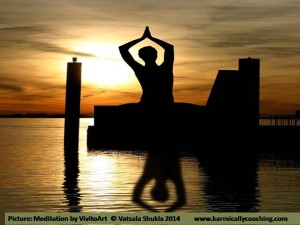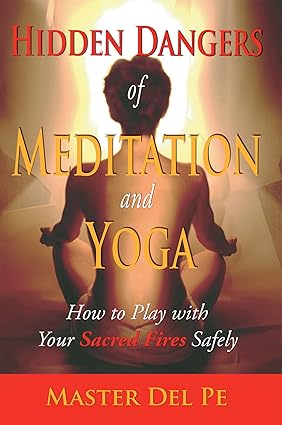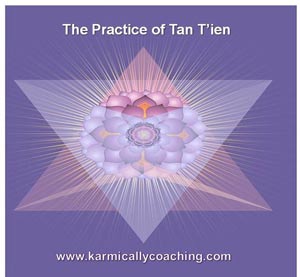
Regular visitors to The Karmic Ally Coaching Experience Blog, know I’m an enthusiastic advocate of meditation, chakra balance and yoga for stress management.
Yet I am careful and cautious in my suggestions based on the individual’s personality and needs.
There are boundaries that should not be crossed. If I feel that it may aggravate the condition or may not help, then I keep quiet or suggest an alternative method to give results.
Quite simply, one size does not fit all.
When Meditation Goes Wrong – Big Time
My stand is based on my own personal experience in relation to a particular type of patented meditation technique.
It has benefited me immensely. Though there are periods when I stop meditating because I start to feel spiritually fried or internally cold.
Both these conditions are caused when there is an excess of spiritual energy or excessive awakening of the Kundalini. I had also started to experience anxiety when there was no need to feel anxious.
In the early days of my meditation journey when I first started to experience these symptoms, my auditor mind said I needed some information.
I spoke to my instructor and asked for an explanation which was not forthcoming. Instead I was told to ignore it and continue meditating for extra periods of time.
Instinctively I did the reverse and stopped meditating for a month.
On resuming my meditation, I was in control again. I now follow a practice better suited to my constitution and temperament.
It would be many years later that I’d get an answer to my question in the form of small talk with a guest whom my sister and brother-in-law had invited for dinner during my visit to Copenhagen.
Our dinner guest told me this particular meditation technique had been popular in treating patients with mental health problems in Denmark until they started committing suicide in hospitals.
I only have this guest’s word for it but more research indicated that there was a known side effect of this form of meditation. This includes chronic dissociation and significantly increasing a phenomenon known as relaxation induced anxiety.
That rang a serious bell in my mind as I remembered my conversation with my old teacher. I decided that while I loved meditation, there had to be a better way and one that was right for me.
Then I chanced upon a book at my favorite Khan Market book shop by the modern mystic Master Del Pe titled Hidden Dangers of Meditation and Yoga: How to play with your Sacred Fires Safely and it all fell into place.
(This is a book that I highly recommend you read if you are into meditation and yoga to know and understand these practices at a deeper level)

I had completely forgotten about this until a recent phone call from someone who is close to me who had a similar experience after a full day course on a different type of Meditation style.
She was experiencing agitation, insomnia and anxiety attacks when the circumstances in her life were peaceful.
My intuition said her upper chakras had become over-active and balancing was required.
Like a doctor, I gave her a prescription and for the next few days did follow- ups. Things worked out and all is well.
One of the exercises that I taught her was to transfer the excess energy into her Tan T’ien or Dantien energy area. You can learn more about it by clicking on the image below ( a new window will open on your browser).
Since I am not the only one who has had this experience (there are many other cases that I know of in my Inner Circle of friends who’ve had similar experiences, this post is dedicated to a checklist for meditation.
I still meditate for relaxation, stress management and to balance my chakras but there are certain do’s and don’ts which I feel every reader who is interested in these tools needs to be aware of.
Guarantee Yourself a Blissful Meditation Experience
For clarity, I’ve divided this checklist into 2 sections – before joining a meditation course and first actions if discomfort starts post meditation.

What you need to do before joining a Meditation Course
- Be clear about what you want to achieve with meditation.
- Do your research carefully about the course. There are many types of meditation – Zen, Transcendental, Mindfulness and more. Read more about the style, benefits, mode of delivery and just about anything that you can find about the meditation.
- Do your research about the organization offering the instruction. Are they accredited? Do they have a website? Are they willing to share the details of satisfied clients and allow you to talk to these clients?
- Check out the credentials of the instructor. How long has the instructor being guiding people into the art of meditation? What training does the instructor have? Can you speak to the instructor pre-enrollment?
- What is the mode of delivery of the meditation course? Does it suit you? If it is online, then does the course also provide for direct communication with an instructor?
Talk to friends or associates about the meditation techniques if any, that they use.
Bottom line: Make an informed decision.
What If You Feel Discomfort Post Meditation?
This discomfort can happen either during or after the first session or even later into the course.
One reason that I can offer is that meditation focuses on the higher chakras. It can also awaken the kundalini and activate the higher chakras while the lower chakras remain closed or under-active.
It is always a good idea to have some readily available solutions for these situations.
Here are a few to keep in your first-aid box
- Stop the meditation practice. This will enable you to ground back and adjust your internal and external conditions.
- Study and analyze which practice has created the situation and avoid it.
- Start doing grounding exercises to strengthen your will-power and connection to the Earth.
- Increase your physical activity to further strengthen your Root Chakra. Take your pick, it could be going to the gym, doing housework, lifting weights or even stamping your feet!
- Avoid negative people and negative talk. You might have become more sensitive and need time to build up your defenses.
- Increase the intake of protein and minerals in your diet.
- Avoid pranayam or any breath holding practice for a while. Instead, do alternative nostril breathing to balance your energies.
- Communicate with people whom you know to be grounded. Focus on your goals in the real world with new and deliberate intent.
- Drink lots of water and avoid alcohol or other stimulating beverages for some time. Take it a step further while bathing. As the water falls off your body, keep telling yourself, “I am washing away any negativity that I have picked up during the day, I am becoming whole again”.
- If you have been taught Mudras (hand gestures) for meditation and still wish to use them when you start to meditate again, then change them to a simple one. Where the thumbs do not connect with any of the fingers but instead the hands are placed on top of each other. This Mudra helps when you just want to relax or just let go. They are called Bhairava (right hand is on top of the left) and Bhairavi (left hand is on top of the right) Mudras for relaxing meditation.
- Release your excess spiritual energy and direct it to a good cause. With palms open, visualize the recipient(s) of your blessing with the gentle intention to let the energy flow out of your hands towards your target.
While the above techniques will help, it is always a good idea to do one’s research first and then enter the realm of meditation. Make your experience a sublime one, not a nightmare.
That’s why I created Your Personal AI Meditation Coach Bundle to help you find the right meditation for you.
Discover a smarter way to calm your mind.
The Your Personal AI Meditation Coach Bundle helps you rewire stress, regulate emotions, and build daily mindfulness habits using AI-powered prompts, adaptive breath work, and neuroscience-based meditation techniques.
Perfect for professionals and women leaders who want peace without slowing down.
Have you experienced any undesired side effects of meditation? How did you handle it?
UPDATE: This blog post was originally written in August 2012 and has been updated in October 2025 for new content and relevance.
Written By: Vatsala Shukla
Photo credit: Meditation by VivitoArt and Vatsala






 I adhere to the Certified Coaches Alliance Code of Ethics and Standards. A copy is available on request.
I adhere to the Certified Coaches Alliance Code of Ethics and Standards. A copy is available on request.
 Let's Talk through the Connect Form:
Let's Talk through the Connect Form: